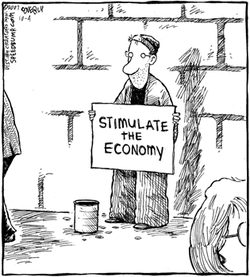Economics 621

Organization of Course
In this course students will meet four times a week for 60 minute periods. Students will maintain a unit specific notebook or file during the course. The notebooks will include activities, vocabulary, key concepts, and questions for each unit. At the end of each unit there will an an in-class assessment which could in the form of a traditional exam style question paper, essay question, an experiment, debate or presentation.
Assessment
Unit Evaluations and Quizzes – 25%
There will be an in-class evaluation after the completion of each unit. This could be in the form of a test, an oral interview, document analysis or writing assignment.
Assignments 30%
Throughout the years students will complete assignments which make use of Web 2.0 tools in addition to case studies, data response questions oral presentations, essays and experiments.
End of Term Exams 35%
The end of term exams will include multiple choice questions, dfree response questions and a short essay question.
Notebook / File 10%
You are required to maintain a notebook throughout the course. Those of you who have taken my classes before will be familiar with this system. All classwork and homework must be completed in the same notebook, and must be in the correct order. Again, those of you who have taken my classes before will know that I produce most of my own resources (worksheets, activities, etc) and you will be required to place these into your notebook. You will be assessed only on the contents of your notebook so it will not be necessary for you to study from any textbooks. I will collect your notebooks periodically to ensure that you are maintaining them properly and to see how you are doing
In this course students will meet four times a week for 60 minute periods. Students will maintain a unit specific notebook or file during the course. The notebooks will include activities, vocabulary, key concepts, and questions for each unit. At the end of each unit there will an an in-class assessment which could in the form of a traditional exam style question paper, essay question, an experiment, debate or presentation.
Assessment
Unit Evaluations and Quizzes – 25%
There will be an in-class evaluation after the completion of each unit. This could be in the form of a test, an oral interview, document analysis or writing assignment.
Assignments 30%
Throughout the years students will complete assignments which make use of Web 2.0 tools in addition to case studies, data response questions oral presentations, essays and experiments.
End of Term Exams 35%
The end of term exams will include multiple choice questions, dfree response questions and a short essay question.
Notebook / File 10%
You are required to maintain a notebook throughout the course. Those of you who have taken my classes before will be familiar with this system. All classwork and homework must be completed in the same notebook, and must be in the correct order. Again, those of you who have taken my classes before will know that I produce most of my own resources (worksheets, activities, etc) and you will be required to place these into your notebook. You will be assessed only on the contents of your notebook so it will not be necessary for you to study from any textbooks. I will collect your notebooks periodically to ensure that you are maintaining them properly and to see how you are doing
The Use of Technology
Throughout the course you will be required to use applications such as Microsoft Office, Google Documents, Windows Movie Maker, Prezi, Weebly and Screencast-O-matic. This could be during a class, for homework or as part of an assignment. It is imperative that you become comfortable with the use of computer technology as you will need to be able use it in your future studies and career.
Throughout the course you will be required to use applications such as Microsoft Office, Google Documents, Windows Movie Maker, Prezi, Weebly and Screencast-O-matic. This could be during a class, for homework or as part of an assignment. It is imperative that you become comfortable with the use of computer technology as you will need to be able use it in your future studies and career.
Digital Textbook
During this course we will be using a digital textbook created by Geoff Riley of Eton College to supplement your reading. This is an excellent resource.
| Economics Textbook |
